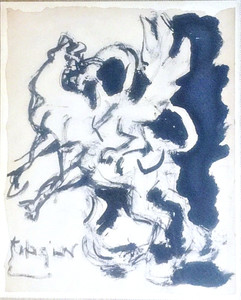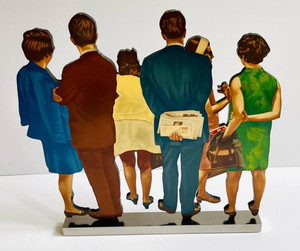
Howard Mehring
Study for Spring Sweep, 1964
Oil, oil stick, charcoal, gouache painting on paper
13 1/2 × 11 × 3/4 in
Unique
Hand-signed by artist, Hand signed, dated and annotated with the names of the colors in graphite pencil on the front
Framed
This 1964 hard edge painting on paper is a study for "Spring Sweep" - an important monumental (82" high) Howard Mehring painting, originally in the collection of the former Corcoran curator and CEO Vincent Melzac. The larger work was exhibited at the Washington, D.C., Corcoran Gallery of Art, Vincent Melzac Collection, December 18, 1970-January 24, 1971, Washington, D.C., Corcoran Gallery of Art, Howard Mehring: A Retrospective, December 10, 1977-January 22, 1978. [exhibition catalogue pp. 52 and 63, no. 38 (illustrated)] The present study is signed, dated, and in fact annotated with the names of the colors - ochre and siena. It is made of oil, oilstick, charcoal and gouache on paper. A rare find.
Measurements:
10 3/4 x 8 1/4 inches (sheet)
13 10/16 11 x 3/4 inches (frame)
Howard Mehring (1931-1978) was a leading Washington DC Color painter. Curator Walter Hopps, asserted: “Mehring was the closest painter to Morris Louis in delicacy… [his work is] simultaneously delicate and bold, a rare combination also present in Jackson Pollock’s work.” Gene Davis identified Mehring as “one of the premier painters” of the Washington Color School, explaining: “In many ways he was the most lyrical of us all.” Mehring’s artistic innovations influenced the works of Gene Davis, Thomas Downing, Alma Thomas and Sam Gilliam. Permanent collections include: Solomon R. Guggenheim Museum; Museum of Modern Art; Whitney Museum of Modern Art, The Tate Gallery, Hirshhorn Museum and Sculpture Garden; National Gallery of Art; Los Angeles County Museum; San Francisco Museum of Art.
A native of Washington, D.C., Howard Mehring studied, lived, and worked in Washington all his life, and became an influential member of the Washington Color School Painters – a group of Color Movement painters including Morris Louis, Kenneth Noland, Gene Davis, Thomas Downing, and Paul Reed.
Mehring graduated from Wilson Teachers College, where he studied under Leon Berkowitz, founder of the Washington Workshop Center for the Arts. In 1953, Berkowitz introduced Mehring to the Washington Workshop, where he formed relationships with Kenneth Noland and Morris Louis. He later joined the faculty and taught alongside Noland, Louis, and Gene Davis. In 1955, Mehring received his M.F.A. from Catholic University, where he made the acquaintance of Thomas Downing.
At the Washington Workshop, Mehring was exposed to the newest New York artists, such as David Smith and Cy Twombly, who exhibited their work at Catholic University at Noland’s instigation. It was through Noland and Louis that Mehring first saw the work of Jackson Pollock, Mark Rothko, Barnett Newman, and Helen Frankenthaler, artists whose work would make a lasting impression on Mehring. These New York artists inspired Mehring to experiment with new techniques of pigment and surface, and the influence of Pollock and Frankenthaler in particular can be seen in much of Mehring’s early work. During a 1955 visit to Frankenthaler’s New York studio, Mehring witnessed Frankenthaler’s technique of staining raw canvas with pigment. Mehring was intrigued by the way Frankenthaler’s staining technique opened up the possibility of unifying color and canvas. Mehring soon began to experiment with mixing paint with metallic powder and pouring it onto canvases. These pouring and staining techniques were enhanced by Leonard Bocour’s invention of Magna, the world’s first type of acrylic paint, which was quickly adopted by Mehring and many of his contemporaries. Staining canvas with acrylic paint allowed Mehring to employ veils of color to create deep, luminous, and ambiguous spaces.













